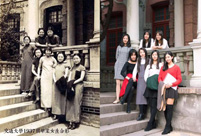

In 2016, the Silk Road Economic Belt and the 21st Century Maritime Silk Road will both be under construction. China, as well as the larger global community, speaks highly of the Belt and Road initiative.
However, lacking a clear understanding of what the Belt and Road initiative entails, some still have doubts about it. Therefore, now is a good time to conduct an in-depth analysis of the goals and larger implications of the initiative, as well as of the opportunities and challenges that it could bring.
The Belt and Road initiative offers both a long-term vision and real benefits in the near future. Some Westerners believe the initiative is nothing more than a concept, lacking a clear roadmap. However, such an interpretation is one-sided.
The Belt and Road initiative is a combination of vision and action. As President Xi Jinping pointed out, the initiative is not an empty slogan, but rather contains tangible measures that will benefit all the involved countries and regions.
In the long run, the initiative will advance world economic development. It will put into practice the idea of openness and inclusiveness, and will pioneer economic globalization.
In the shorter term, the initiative will significantly boost employment and economic development in the post-financial crisis era. With joint efforts between different countries and regions along the route, and by aligning the booming Asian economic sphere with the European one, the Belt and Road initiative will stimulate huge market demand, acting as an engine for global economic development.
The Belt and Road initiative comes from China, but it will make a difference far beyond China’s borders. China’s modernization process has set a precedent for other developing countries. Making up 63 percent of the world population, countries along the Belt and Road route only account for 29 percent of the global economic aggregate. These mismatched numbers call for drastic measures to address the gap.
Meanwhile, the opportunities and risks that come with the initiative must be viewed objectively. Some commentators have twisted the initiative into “China’s Marshall Plan.” This misunderstanding fails to grasp China’s desire for peaceful development and mutually beneficial cooperation.
As Xi has explicitly stated on many occasions, the Belt and Road initiative is not meant to establish a sphere of influence, but to weave a partnership network.
Of course, potential risks during the construction must be acknowledged. And it is because of those risks that the construction is being done through joint consultation, joint construction and sharing. We should neither exaggerate nor overlook these risks; an objective view is what is called for in this moment.
Looking ahead, there are three relationships that must be properly handled as the Belt and Road initiative progresses.
The first is the relationship between the government and the market. The promotion of the Belt and Road initiative must be government-led and enterprise-centered, while still adhering to market operations and complying with international standards.
The second relationship is the one between “give” and “take,” which must be emphasized in the initial stages of construction. Most countries along the route are developing countries. Therefore, significant investment is required at present, and the return on that investment will come later. Thus, the correct stance for now should be more “give” and less “take.” Only by maintaining this stance can we expand the domestic market into Eurasia and Africa.
Last but not least is the relationship between governmental and social organizations. Chinese enterprises that hope to go global should place emphasis on interaction with local government and non-governmental organizations. The political systems of different countries must be respected. Overseas Chinese companies should strictly abide by the Silk Road spirit; the strategy of Made in China, China Service and other brands is to strive for localization.
(The author is a senior researcher at the Chongyang Institute for Financial Studies of Renmin University.)
 Thai most beautiful transgender Nong Poy release new photos
Thai most beautiful transgender Nong Poy release new photos Now and then photos of Shanghai Jiaotong University
Now and then photos of Shanghai Jiaotong University Is this what air travel will look like in 2050?
Is this what air travel will look like in 2050? Aerial view of watermelon terraces in S China's Baise
Aerial view of watermelon terraces in S China's Baise Traditional wedding of a post-80s Tibetan couple
Traditional wedding of a post-80s Tibetan couple Models in cheongsams present classical oriental beauty
Models in cheongsams present classical oriental beauty Second commissioned C28A corvette made by China enters Algerian Navy
Second commissioned C28A corvette made by China enters Algerian Navy Intoxicating Wuyuan in spring
Intoxicating Wuyuan in spring Gold and silver wares of Qing Dynasty exhibited in Shenyang Imperial Palace
Gold and silver wares of Qing Dynasty exhibited in Shenyang Imperial Palace Top 20 hottest women in the world in 2014
Top 20 hottest women in the world in 2014 Top 10 hardest languages to learn
Top 10 hardest languages to learn 10 Chinese female stars with most beautiful faces
10 Chinese female stars with most beautiful faces China’s Top 10 Unique Bridges, Highways and Roads
China’s Top 10 Unique Bridges, Highways and Roads Challenges seen in attracting foreign capital
Challenges seen in attracting foreign capital  Suspected matricide case highlights mental health problems in China’s elite colleges
Suspected matricide case highlights mental health problems in China’s elite colleges  Peering into North Korea from China’s border
Peering into North Korea from China’s border  Cross-Straits ‘diplomatic truce’ still holds
Cross-Straits ‘diplomatic truce’ still holds Day|Week